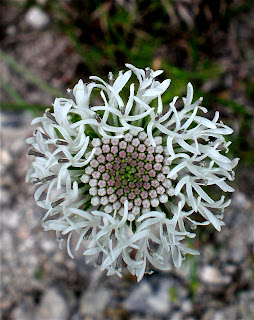In this post I'm featuring Composite flowers (Aster Family) because they are really taking over dominance of the Central Texas landscape this time of year. Everywhere you go you will see them, and along many roadsides and fields you'll see masses of these flowers. You will probably be familiar with the garden representatives of these in the sunflowers, carnations, marigolds and dandelions.
The reason why there are so many kinds and such great quantities of these is because of the highly successful flower structure this family employs. Although you may think you are looking at a single flower, each flower head really has dozens to hundreds of individual flowers. Thus the name: Composite. I've included a few diagrams of flower parts to help explain this efficient structure.
First are two diagrams of regular simple flowers to get you familiar with flower part names. Then, follows a diagram of a Composite flower, using the beloved Indian Blanket.
Many composites are nick-named by botanists the DYC's, which stands for Darn Yellow Composites, because there are so many that are yellow and look very similar that it can be difficult to decipher which exactly a specimen is.
The Simple Flower
Each flower head has many tiny individual flowers
Both Ray and disk flowers have all the flower parts: Stamens (male parts) and Pistils (female parts). These parts are compact, partly fused and streamlined so that many flowers can fit in one head. Lots of flowers = Lots of seeds.The disk flowers don't open all at once, but in many species, the outer disk start opening first, then in time, the opening process moves inward. This insures pollination of at least some of the florets as they are all maturing over an extended time. Some Composite flowers species have only ray flowers, some have only disk, and many have both.
The Pics below are of Aster family members blooming in April/May in the Texas Hill Country. Other species of composites will not start blooming till the summer or fall.
Composite Examples
There are two types of flowers:
Ray flowers that carry the petal like structure (like rays of the sun coming out of the suns disk)
Disk flowers in the flowers center.
Disk flowers in the flowers center.
 |
Key Features of Composite Flower structure:
Both Ray and disk flowers have all the flower parts: Stamens (male parts) and Pistils (female parts). These parts are compact, partly fused and streamlined so that many flowers can fit in one head. Lots of flowers = Lots of seeds.The disk flowers don't open all at once, but in many species, the outer disk start opening first, then in time, the opening process moves inward. This insures pollination of at least some of the florets as they are all maturing over an extended time. Some Composite flowers species have only ray flowers, some have only disk, and many have both.
The Pics below are of Aster family members blooming in April/May in the Texas Hill Country. Other species of composites will not start blooming till the summer or fall.
Composite Examples
 |
| Prairie Fleabane |
 |
| Fiveneedle Pricklyleaf |
 |
| Blackfoot Daisy |
 |
| Dwarf White Aster |
 |
| Greenthread (Thelesperma filifolium) |
 |
| Damianita |
 |
| Engelmann Daisy |
 |
| White Barbara's Buttons, Puffballs. This composite has no ray flowers only disk flowers |
 |
| Greenthread (Thelesperma filifolium) |
 |
| Texas Star |
 |
| Indian Blanket, Firewheel |
 |
| White Rocklettuce. This composite has mostly ray flowers or ray-like flowers |
 |
| Shrubby Boneset |
 |
| Texas Thistle |
 |
| Texas Thistle |




















